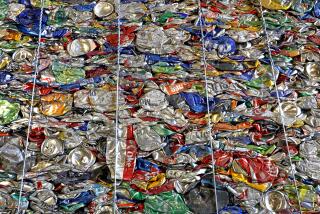Called Historic Step : Ambitious Recycling Plan Wins County OK
Fearful of an impending trash disposal crisis, San Diego County supervisors approved an ambitious recycling program Tuesday that ultimately could require residents and businesses to separate aluminum cans, glass, paper and other recyclable materials from the rest of their garbage.
With Supervisor Susan Golding hailing her colleagues’ unanimous action as a “truly historic step,” the board approved a long-range recycling program aimed at reducing the amount of solid waste in county landfills by 30% within five years.
Though the nine-point plan includes a variety of voluntary steps and recycling education programs, the supervisors indicated that they expect some of the provisions to become mandatory within several years. No firm timetable was specified, but the supervisors directed county administrators to report back early next year with a proposed schedule on how to phase in mandatory garbage separation and other requirements.
“It is my firm personal belief that this will not be successful without mandatory measures,” Golding said. Other supervisors agreed that a combination of mandatory requirements and economic incentives may be necessary in order to achieve widespread public compliance with the recycling program.
The mandatory measures that could be in place by the early 1990s in the unincorporated areas of the county include so-called “source separation” of garbage at residences and businesses alike and curb-side collection of recyclable materials.
Waste Composition Study
As a first step toward those and other possible mandatory measures, the county, under Tuesday’s action, plans to conduct a waste composition study to determine precisely how much recyclable material can be found in local trash and its potential revenue. That study is expected to be completed by next summer, county officials said.
3.6 Million Tons a Year
“Before any mandatory requirements kick in, we have to find out how much recyclable material there is in the waste stream, how we’re going to collect it and what we’re going to do with it after we have it,” Golding explained.
County administrators estimate that each resident generates about 1.6 tons of solid waste annually, producing a countywide total of about 3.6 million tons of garbage a year. With that total increasing by about 10% a year, the capacity of the five county-operated landfills is expected to be exhausted by the late 1990s.
New landfill sites, trash-to-energy plants and other emerging waste-disposal technologies figure prominently in the county’s long-range approach to its garbage problem, county officials emphasize. Recycling, no matter how successful, cannot solve the problem, they acknowledge, but at least can add years to the life of local landfills, thereby giving the county more time to search for solutions.
Currently, less than 10% of San Diego’s solid waste is recycled, according to county figures. Through the program approved Tuesday, however, the supervisors hope to reduce by 30% the amount of solid waste that enters the county’s landfills and other waste treatment facilities by 1992.
‘We Have to Change Habits’
“What we have to do is change habits,” Golding said of the recycling program. “Changing habits is difficult, but . . . we really are running out of time, if we haven’t run out of time already. We have to proceed with due speed because the other alternatives (for trash disposal) are fast disappearing.”
The just-approved program, lavishly praised by environmentalists, trash-disposal industry representatives and others, calls for voluntary separation of natural vegetation such as leaves, grass and tree branches for composting, rather than dumping them in landfills. If the voluntary approach proves ineffective, that provision, too, could become mandatory.
Other provisions include changes in county purchasing policies to encourage the use of recyclable items, a countywide recycling education program, a review of possible ordinances to restrict the use of non-biodegradable packaging materials and an expansion of existing recycling programs at county garbage disposal facilities.
Over the next several months, county officials also plan to review potential legal questions related to mandatory recycling requirements. Supervisor Brian Bilbray, for example, raised the question of whether landlords or individual tenants would be held responsible if garbage were not properly separated in an apartment complex trash bin.
The supervisors also are exploring whether cities that use county dumps could be required to implement recycling programs.
“We don’t have all the answers today,” Golding said. “But this action shows . . . that the board is moving into recycling in a very major way. And it’s not a minute too soon.”
More to Read
Sign up for Essential California
The most important California stories and recommendations in your inbox every morning.
You may occasionally receive promotional content from the Los Angeles Times.










